10 Best Native Plants for Idaho
BY MICHELLE SELZER | MAY 14TH, 2023 | IDAHO, LAWN CAREIdaho is known for its beautiful landscape, which includes mountains, rivers, and valleys. Throughout the terrain grows many native plant species, including trees, shrubs, and wildflowers. The best native plants for Idaho are attractive, low-maintenance, and great for the local ecosystem. So, we researched and compiled a list of Idaho’s most sought-after vegetation.
In this article:
- Common Yarrow
- Golden Currant
- Lewis’ Mock Orange
- Chokecherry
- Big Sagebrush
- Arrowleaf Balsamroot
- Common Snowberry
- Rocky Mountain Maple
- Bush Penstemon
- Bluebunch Wheatgrass
- How to Choose Native Plants for Your Idaho Landscape
- FAQ About Native Idaho Plants
- Where to Find Native Plants in Idaho
10 Best Native Plants for Idaho
1. Common Yarrow (Achillea Millefolium)
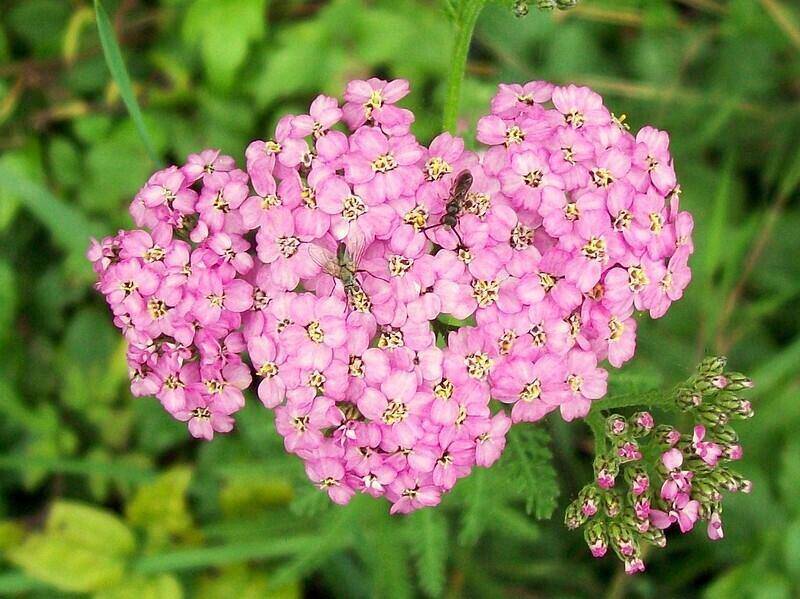
Photo Credit: Peter O’Connor aka anemoneprojectors / Flickr / CC BY-SA 2.0
Common yarrow is a flowering plant native to rocky hillsides throughout South and Central Idaho. Its white, yellow, or pink flower clusters sit beside green fern-like leaves. Although it’s deer-resistant, an occasional deer may come for the fresh juicy stems that emerge in spring. Additionally, butterflies and ladybugs love its nectar.
Aside from its beauty and wildlife support, many homeowners grow yarrow for home remedies that treat indigestion, heartburn, or menstrual cramps. Some people call yarrow “soldiers” or “woundwort” because, during the Civil War, its leaves treated bloody wounds. In addition, Native Americans used yarrow tea to treat headaches and toothaches.
Plant type: Herb
USDA Hardiness Zone: 4 – 8
Sun: Full to partial sun
Soil: Well drained soil, Prefers sandy loams
Duration: Perennial
Foliage: Evergreen
Fragrance: Spicey
Bloom time: April – September
Water needs: Medium, Drought tolerant
Mature height: 3 feet
Potential hazards: Continuous ingestion may cause a skin rash. Some people are allergic to its sap.
Maintenance needs: Regularly prune and deadhead.
2. Golden Currant (Ribes Aureum)
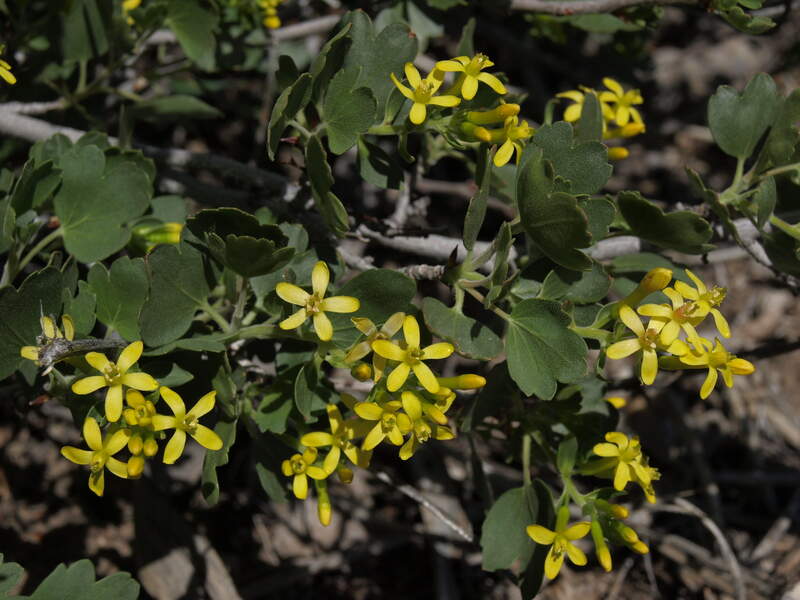
Photo Credit: Jim Morefield / Flickr / CC BY-SA 2.0
Golden currant is a flowering shrub native to hillsides and river valleys throughout Idaho. It’s an attractive plant that supports local wildlife and is often grown as hedges. In early spring, yellow flowers bloom that will later turn orange. Beside its flowers are light green leaves and orange, black, or red berries. Pollinators feast on golden currant’s nectar, while birds eat its seeds.
Plant type: Shrub
USDA Hardiness Zone: 3 – 8
Sun: Full to partial sun
Soil: Well-drained, organically rich
Duration: Perennial
Foliage: Deciduous
Fragrance: Spicy and sweet
Bloom time: March-July
Water needs: Low, Drought-tolerant
Mature height: 3 – 10 feet
Potential hazards: They are non-toxic, but some people get a headache or upset stomach if they eat too much.
Maintenance needs: Mulch helps them thrive.
3. Lewis’ Mock Orange (Philadelphus Lewisii Pursh)
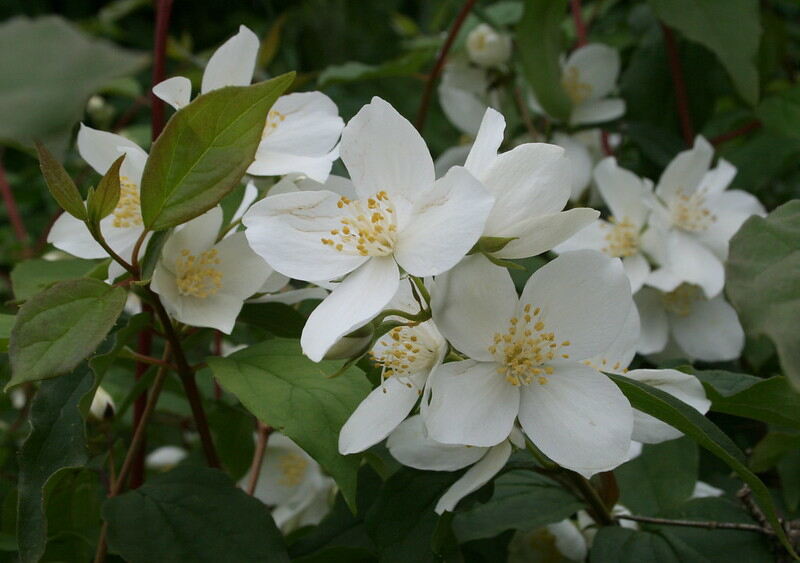
Photo Credit: born1945 / Flickr / CC BY 2.0
Lewis’ mock orange, also called syringa, is Idaho’s state flower. It natively grows throughout North, Central, and Southwest Idaho and is most notable for its fragrant white flowers. The delightful orangey scent attracts many pollinators, such as hummingbirds, butterflies, and bumble bees.
Overall Lewis’ mock orange is a lovely shrub that smells delicious. Its big beautiful flowers are complemented by green oval leaves that turn yellow in the fall and small green fruit. However, be careful if you have sensitive skin because touching it may give you a rash.
Plant type: Shrub
USDA Hardiness Zone: 4 – 8
Sun: Full to partial sun
Soil: Rocky, nutrient-rich, and well-drained
Duration: Perennial
Foliage: Deciduous
Fragrance: Sweet, orangey, citrus scent
Bloom time: Early spring and summer
Water needs: Medium; water in the absence of rain
Mature height: 4.5 – 9 feet
Potential hazards: If you have sensitive skin, it could give you a skin rash.
Maintenance: Low; prune old stems to encourage new growth
4. Chokecherry (Prunus Virginiana)
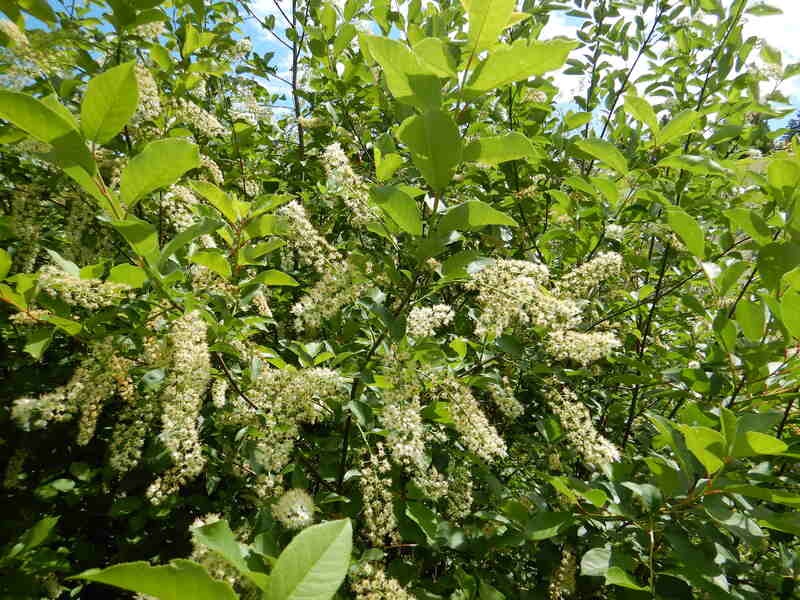
Photo Credit: Matt Lavin / Flickr / CC BY-SA 2.0
Chokecherry, or bitterberry, is a native tree with spectacular shade tolerance that forms thickets throughout Idaho. It has attractive clusters of white flowers complimented by red or purple fruit. Although bitter, its fruit is edible and makes tasty jams and sauces. In addition, many animals enjoy snacking on chokecherry fruit through the summer.
Overall, chokecherry is easy to grow and maintain, but be aware of its downfalls. Parts of the tree contain toxins that can harm livestock, and its leaves can sometimes cause death when ingested. Additionally, chokecherry is susceptible to insects and diseases.
Plant type: Tree
USDA Hardiness Zone: 2-7
Sun: Full sun to full shade
Soil: Moist limestone-based, sand, loam, clay
Duration: Perennial
Foliage: Deciduous
Fragrance: Bittersweet
Bloom time: April – July
Water needs: Low – Medium, Drought tolerant
Mature height: 20 – 30 feet
Potential hazards: Its leaves, bark, stem, and seed pit are poisonous and harmful to livestock.
Maintenance needs: The best time to prune is late winter to early spring.
5. Big Sagebrush (Artemsia Tridentata Nutt.)
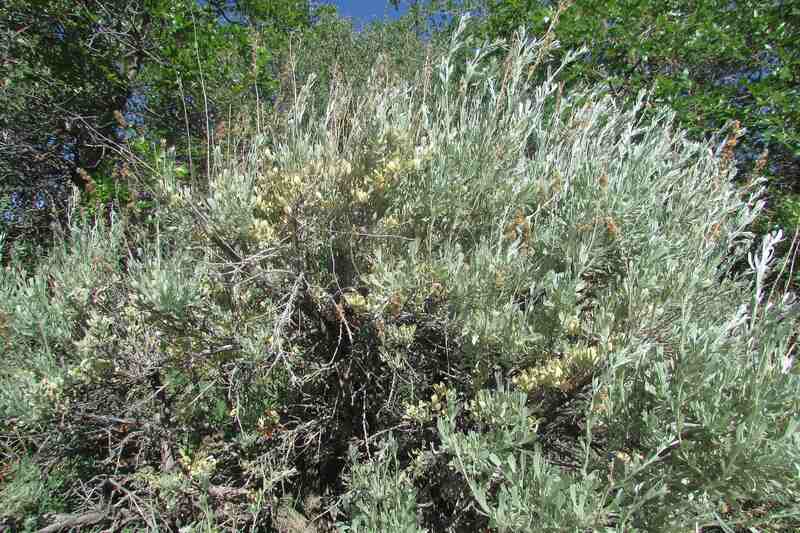
Photo Credit: Chris Light / Wikimedia Commons / CC BY-SA 4.0
Big sagebrush is an evergreen shrub native to North Central, Central, and South Idaho. Recognized for its silvery leaves, many Idaho homeowners grow it as hedges or groundcover. In addition, some people use its highly flammable branches as firewood.
It is effortless to care for and provides food and shelter for many animals, including sage grouse, antelope, and rabbits. Big sagebrush is exceptionally drought-tolerant and resistant to deer and most pests and diseases. However, it can get root rot from overwatering.
Plant type: Shrub
USDA Hardiness Zone: 4 – 9
Sun: Full sun
Soil: Dry, rocky soil
Duration: Perennial
Foliage: Evergreen
Fragrance: Sweet
Bloom time: June – November
Water needs: Medium, Drought-tolerant
Mature height: 3-15 feet
Potential hazards: They are very flammable.
Maintenance needs: Leave 4-5 sets of new branches when you prune.
6. Arrowleaf Balsamroot (Balsamorhiza Sagittata)
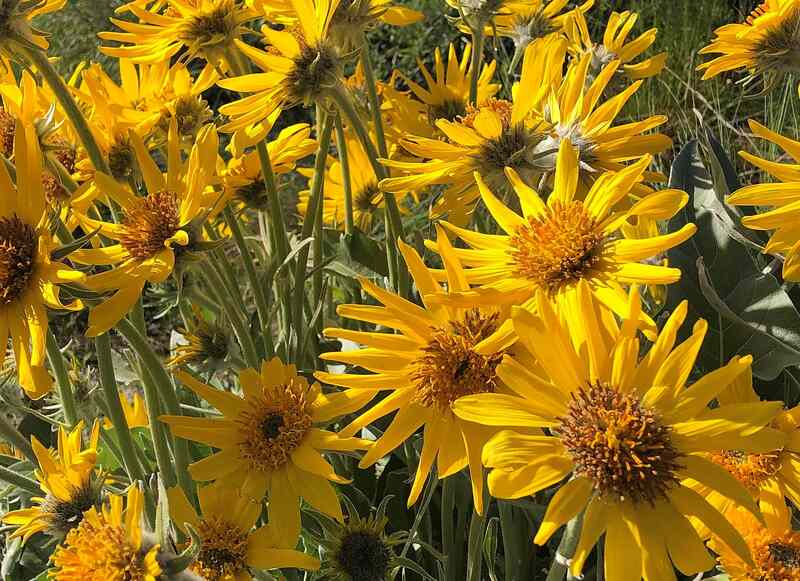
Photo Credit: Lunar Magpie / Wikimedia Commons / CC BY-SA 4.0
Arrowleaf balsamroot is an herb native to hillsides throughout Idaho, and you can find it in many wildflower seed mixes. Its large yellow flowers typically grow one per stalk and look similar to sunflowers. Beside its flowers are big arrow-shaped leaves that have a striking silvery-green color.
Parts of arrowleaf balsamroot are edible for people and wildlife. Native Americans ate its seeds, roots, and shoots, and herbivores like deer and elk enjoy its leaves, stems, and flowers. Additionally, birds feed on its seeds.
Plant type: Herb
USDA Hardiness Zone: 4 – 7
Sun: Full sun
Soil: Moist sandy or gravelly soils
Duration: Perennial
Fragrance: Mild, spicy chocolate
Bloom time: April – July
Water needs: Medium
Mature height: 8-24 inches
Potential hazards: They are intolerant to disturbances and don’t transplant well.
Maintenance needs: It may need occasional deadheading.
7. Common Snowberry (Symphoricarpos albus)
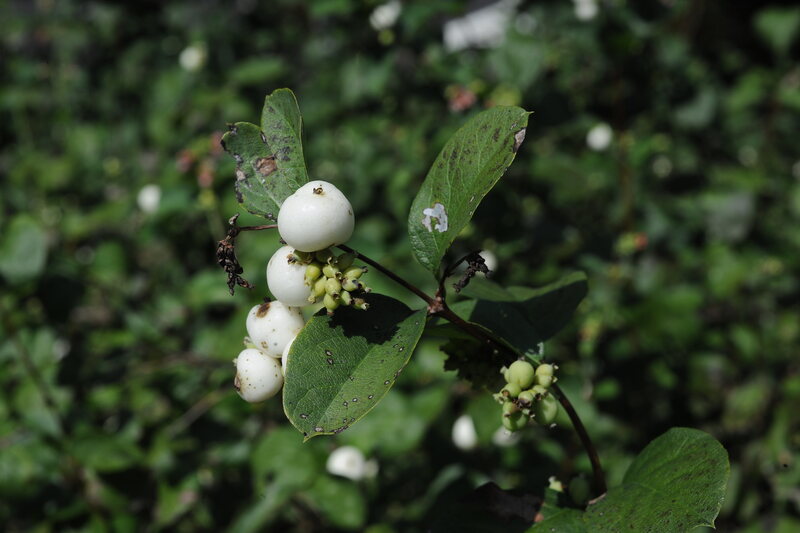
Photo Credit: Joost J. Bakker IJmuiden / Flickr / CC BY 2.0
Common snowberry is a bushy shrub found in dry prairies throughout Idaho. It has white and pink flowers, dark green leaves, and showy white fruit. Although common snowberry will grow in partial shade, it bears more fruit in full sun.
Aside from its looks, snowberry is a vital winter food for many animals, including chipmunks and deer. It also nourishes several birds, including songbirds, quail, and pheasants.
Plant type: Shrub
USDA Hardiness Zone: 3 – 7
Sun: Partial to full shade
Soil: Adadbtabe
Duration: Perennial
Foliage: Evergreen
Fragrance: Berries, mint, and cinnamon
Bloom time: July – September
Water needs: Low
Mature height: Up to 6 inches
Potential hazards: The berries are toxic to humans and some pets.
Maintenance needs: Early spring is the best time to prune.
8. Rocky Mountain Maple (acer glabrum)
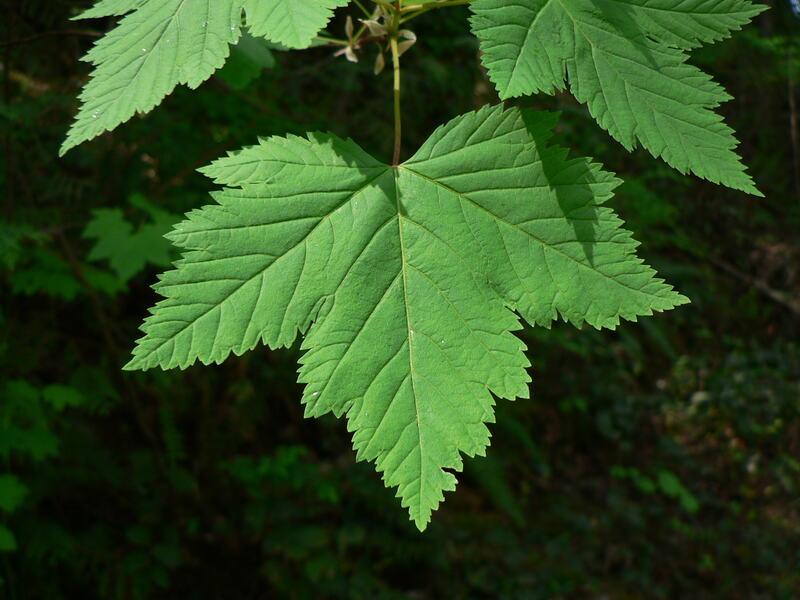
Photo Credit: Walter Siegmund / Wikimedia Commons / CC BY-SA 3.0
The Rocky Mountain maple is a dainty tree native to Idaho’s canyons, mountains, and wetlands. Many Idahoans choose the Rocky Mountain maple because it’s attractive and low maintenance. Its yellow and green flowers bloom in the spring, and its shiny green leaves turn breathtaking shades of red, orange, and yellow in the fall.
Plant type: Tree
USDA Hardiness Zone: 4 – 8
Sun: Full sun
Soil: Moist, well-drained, rocky soil
Duration: Perennial
Foliage: Deciduous
Fragrance: Strong
Bloom time: April – May
Water needs: Low
Mature height: Up to 30 feet
Potential hazards: It is moderately flammable and should be at least 50 feet from your home.
Maintenance needs: Keep the soil moist, especially during summer to avoid scorching leaves.
9. Bush Penstemon (Penstemon fruticosus)
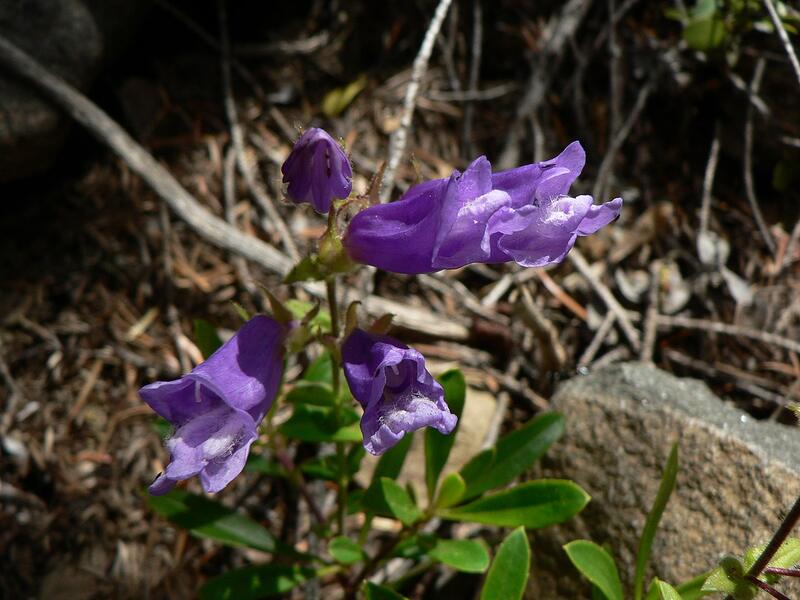
Photo Credit: Walter Siegmund / Wikimedia Commons / CC BY-SA 3.0
Bush penstemon, or shrubby penstemon, is a native herb that is easy to transplant and effortless to maintain. Its showy lavender, blue, and violet flowers sit beside dark green leaves that turn reddish in the fall. It grows wider than tall and attracts moths, butterflies, and hummingbirds.
Plant type: Herb
USDA Hardiness Zone: 3 – 9
Sun: Full sun to partial shade
Soil: Rocky, sandy or regular garden soil
Duration: Perennial
Foliage: Deciduous
Fragrance: Rose-like
Bloom time: Early summer
Water needs: Low – Medium
Mature height: 6 – 16 inches
Potential hazards: It is non-toxic, but unhealthy for pets to eat.
Maintenance needs: Requires little to no maintenance.
10. Bluebunch Wheatgrass (Pseudoroegneria spicata)
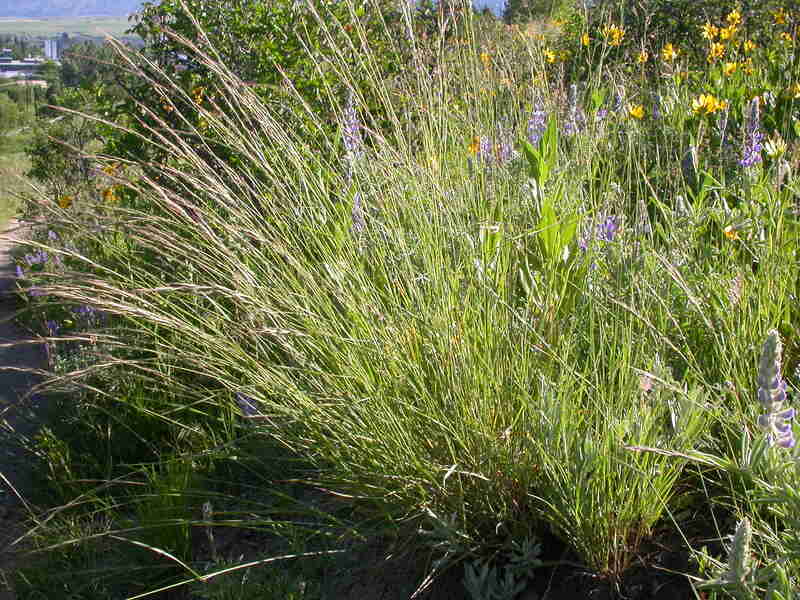
Photo Credit: Matt Lavin / Wikimedia Commons / CC BY-SA 2.0
Bluebunch wheatgrass is a native cool-season grass found in Idaho’s mountains and valleys. It grows well from seeds and is quick to establish. Both livestock and wildlife enjoy grazing on it. However, it takes about two growing seasons to be strong enough for feeding, and bluebunch wheatgrass never gets the strength to handle heavy grazing.
Plant type: Grass
USDA Hardiness Zone: 3 – 7
Sun: Full sun
Soil: Dry rocky soil
Duration: Perennial
Bloom time: June – August
Water needs: Low, Drought tolerant
Mature height: 1 – 3 feet
Potential hazards: It is a mild allergene.
Maintenance needs: Low maintenance
How to Choose Native Plants for Your Idaho Landscape
When choosing native plants for Idaho, please consider the following:
- USDA hardiness zone: Choosing the right plant for your hardiness zone is important. North Idaho starts in Zone 3, and southern Idaho stops in Zone 7. Boise is in zones 6b – 7a.
- Soil conditions: The soil throughout Idaho is a light silty loam called Threebear soil. Additionally, yards on south-facing slopes typically have dryer soil than yards on north-facing slopes.
- Sunlight: Some plants thrive in shade, while others thrive in full sun. Select plants that prefer the sunlight your landscape provides.
- Landscape design: Consider colors, textures, and proportions when styling your yard.
- Children and pets: If you have children or pets, avoiding toxic or sharp plants is best.
FAQ About Native Idaho Plants
The best native plants for Boise foothills include the following:
● Big Sagebrush
● Antelope Bitterbrush (Purshia tridentata)
● Rubber rabbitbrush (Ericameria nauseosa)
● Netleaf hackberry (Celtis laevigata)
The best native plants for North Idaho include the following:
● Chokecherry
● Golden Currant
● Common Snowberry
● Bush Penstemon
● Bluebunch Wheatgrass
● Saskatoon Serviceberry (Amelanchier alnifolia)
● Kinnikinnick (Arctostaphylos uva-ursi)
● Bunchberry Dogwood (Cornus canadensis)
● Conifer Broomrape (Orobanche pinorum)
In addition to the plants on our list, homeowners in Central Idaho should consider these native plants:
● Creeping Oregon Grape (Mahonia repens)
● Antelope Bitterbrush (Purshia tridentata)
● Lewis Flax (Linum lewisii Pursh)
● Conifer Broomrape (Orobanche pinorum)
The best native plants for Twin Falls include:
● Chokecherry
● Golden Currant
● Big Sagebrush
● Arrowleaf Balsamroot
● Bluebunch Wheatgrass
● Western Columbine (Aquilegia formosa)
● Showy Milkweed (Asclepias speciosa)
Where to Find Native Plants in Idaho
You can purchase idaho native plants at the following nurseries:
- North Fork Native Plants in Rexburg
- Cedar Mountain Perennials in Athol
- Twin Peaks Nursery in McCall
- University of Idaho Franklin H. Pitkin Research Nursery in Moscow
- Plant Natives Nursery in Lewiston
- Wildlife Habitat Nursery in Princeton
And you can view native plants at the these nature preserves and gardens:
- Kinnikinnick Native Plant Society in Sandpoint
- Treasures of the Boise Front in Boise
- Cougar Bay Nature Preserve in Coeur d’Alene
- Golda Harris Nature Preserve in Boise
The best way to maintain a pristine landscape is to hire a lawn care pro near you. Experienced professionals know what it takes for your lawn to thrive. In addition to maintaining the lawn, a lawn care pro can tidy up your yard, trim your bushes, and edge native garden beds. Then, with the time you save, you can visit Yellowstone National Park or Perrine Memorial Bridge.
Main Image Credit: Cory Maylett / Wikimedia Commons / CC BY-SA 3.0